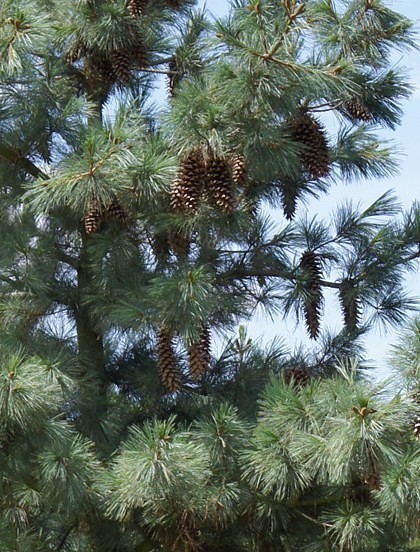Pinus × schwerinii, as described in 1930 by Jost Fitschen (1869-1947), in Beissner's, Handbuch der Nadelholzkunde, ed.3, is commonly known as Schwerin's pine. The species name honors German botanist, Fritz Kurt Alexander von Schwerin (1847-1925), who found the first plants in his palace park in Wilmersdorf, Berlin, Germany.
Description. Schwerin's pine is a spontaneous garden hybrid that has also be deliberately recreated. The parents are two widely geographically, as well as ecologically separated species of typical white pines (subsection Strobus), namely Eastern white pine (Pinus strobus) and Himalayan white pine, (Pinus wallichinana). The first found seedlings of this hybrid were derived from P. strobus seed, but the reciprocal cross has proven to be easier to recreate.
- Hybrids grow in a vigorous tree form with a broad, conical crown resembling that of P. wallichiana because of the drooping needles. It also has excellent resistance to white pine blister rust (Cronartium ribicola).
- Bark remains smooth and light gray for extended periods.
- Twigs resemble those of Himalayan white pine in their green to greenish brown color and way coating. Twigs of Eastern white pine are minutely hairy in comparison.
- Foliage (needles) is concentrated at the ends of each years's twigs. At 3.2 to 4.8 inches (8 - 12 cm) long, they are of intermediate length of the parents, longer than P. strobus and shorter than P. wallichiana. They are bright- to bluish green in color resembling forms of both parents.
- Seed cones are comprised of circa 60 seed scales, and measure 4 to 8 inches (10 - 20 cm) long and 2.4 inches (6 cm) wide, much larger than those of the typical Eastern white pine, but significantly smaller than those of the Himalayan white pine.
- Cones are attached by a 0.8 to 1.6 inch (2 - 4 cm) long peduncle, similar to P. wallichiana, but longer than seen in P. strobus.
- Cone scales open wider than those of either seed parent.
- Seeds measure 0.28 to 0.36 inch (7 - 9 mm) long with a 0.8 to 1 inch (20 - 25 mm) long wing, falling near the upper end of Eastern white pine's range of seed size and the lower end of that of Himalayan white pine. However there is considerable overlap within seed sizes of the two species.
This hybrid is a promising opportunity for introducing rust resistance into white pine plantations world-wide.
Hardy to USDA Zone 7 - cold hardiness limit between 0° and 10°F (-17.7° and -12.2°C).
